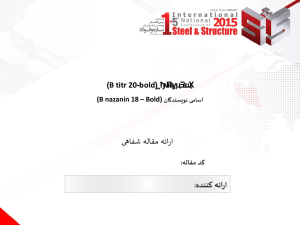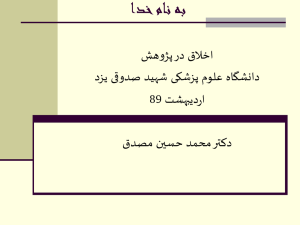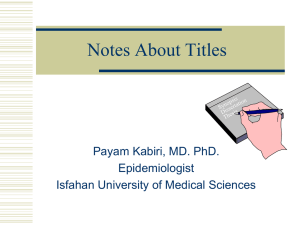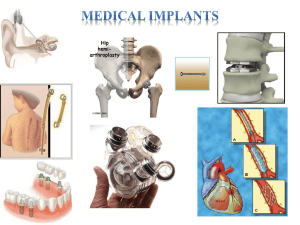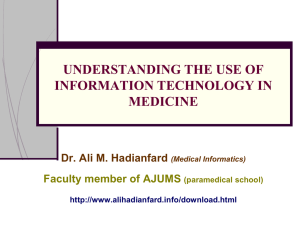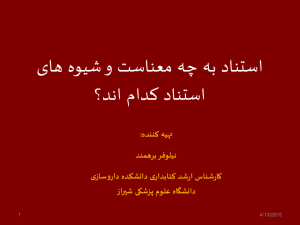Introduction
advertisement
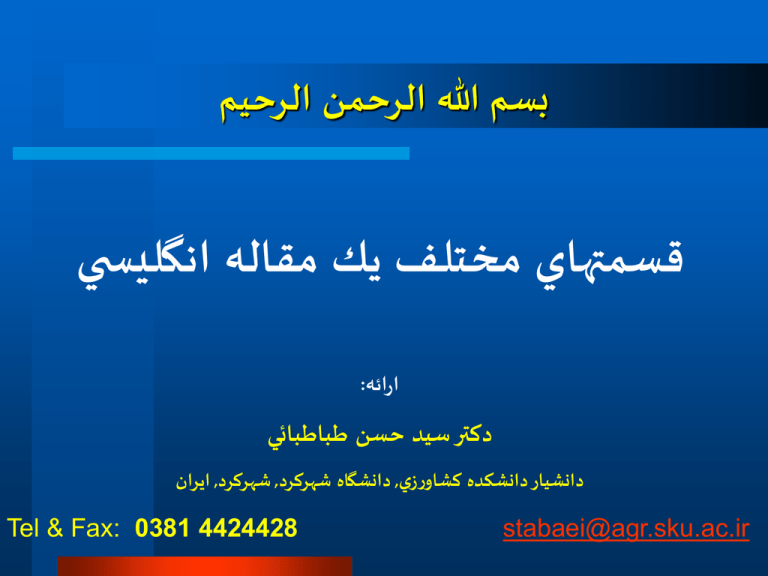
بسم هللا الرحمن الرحيم قسمتهاي مختلف يك مقاله انگليس ي ارائه: دکتر سيد حسن طباطبائي دانشيار دانشکده کشاورزي ,دانشگاه شهرکرد ,شهرکرد ,ايران stabaei@agr.sku.ac.ir Tel & Fax: 0381 4424428 موضوعات مورد بحث براي نوشتن يك مقاله انگليس ي از كجا شروع كنيم؟ بخشهاي مختلف يك مقاله موارد مورد توجه در هر بخش جمع بندي Start to write from ? Parts of a paper 1. Title 2. Abstract 3. Introduction 4. Materials and Methods 5. Results and discussions 6. Conclusions 7. Acknowledgments (optional) 8. References Parts of a paper in presentation 1. Title + authors names 2. Abstract: summary of the ‘why’, ‘how’ and ‘results’ ! 3. Introduction: status of knowledge (with references to key literature), hypotheses and objectives 4. Materials: detailed description of the materials, data monitoring, conducted laboratory experiments, etc. 5. Methods: detailed description of methods and performed research 6. Results (and discussions): description of the research results followed by interpretation of findings 7. Conclusions (or Final comments and conclusions): summary of paper 8. 9. Acknowledgments References Parts of paper in Writing 1. Write the ‘Materials and methods’ first 2. Structure the tables and figures 3. Results 4. Conclusions 5. Introduction 6. Discussions 7. Revisit the ‘Conclusions 8. Prepare the ‘References’ 9. Write the ‘Abstract’ last 10. Reviewing the completed manuscript 11. Submitting the manuscript for consideration for publication Reference: Some suggestions and guidelines for preparation of manuscripts for submission for consideration for publication Animal Feed Science and Technology 134 (2007) 181–188 doi:10.1016/j.anifeedsci.2007.02.0 07 Parts of paper in Writing In general it is easiest to start writing RESULTS and MATERIALS and METHODS. Next, write the INTRODUCTION, then DISCUSSION, and finally ABSTRACT. The TITLE is critical- it must be short and ” bigpicture” without over selling.\ Title Title Describe in as few as words possible the contents of the paper. Few people may read the whole paper, but many will read the title either on the internet or in indexing services. Title عنوان مقاله کوتاه (حداکثر 15کلمه)، حاوى موضوع کلى و جهت گيرى پژوهشگر در آن موضوع ، هماهنگ با متن مقاله ، ترجمه صحيح و دقيق به زبان انگليس ي، اجتناب از بکارگيري اختصارات، اجتناب از بيان پرسش ي ، Authors and Addresses Include professional address and email address of each author. Order of authors: – alphabetically or – in order of amounts of contribution Corresponding author ? Resolve Authorship issues. Corresponding author is usually senior author Authors and Addresses نام و نامخانوادگي نويسنده(گان)، نشاني و آدرس پست الكترونيكي و شماره تلفن نويسنده (گان) ،محل كار و مرتبه علمي نويسندگان بايد ترتيب درج اسامي خود را مشخص نمايند تعيين نويسنده مسئول Authorship Guidelines on authorshop, International committee of Medical Journal Editors, Reprinted by kind permission of the Editor of the British Medical Journal of Sept 14, 1985. J Clin Pathol 39: 110, 1986 Authorship کار گروهي لطفا : مقاله گروه را از نظر سبک و شيوه ارائه عنوان بررس ي و تحليل کنيد. هر يک از نمايندگان گروهها ،نتايج بررس ي را در مدت 4دقيقه گزارش شفاهي مي نمايد. Abstract Abstract A summary, consisting of not more than 250 words. Should be self-contained. Do not include bibliographic information, figures, tables. Use language that will be understood by potential readers. A good abstract will enable readers to determine if they want to read the whole document. Abstract State the general objectives. Describe the methodology used. Summarize the results. State the main conclusions. Most people write the abstract after writing the paper. Keywords and Phrases Keywords and phrases that are necessary to index and classify your paper. کار گروهي لطفا : مقاله گروه را از نظر سبک و شيوه ارائه چكيده بررس ي و تحليل کنيد. هر يک از نمايندگان گروهها ،نتايج بررس ي را در مدت 4دقيقه گزارش شفاهي مي نمايد. Introduction INTRODUCTION State your purpose and review what is already known, citing the literature. Describe the importance of the problem you are considering. The first paragraph is crucial for catching the attention of the audience and for conveying to them the importance of the questions that you have addressed in the paper. If you don’t’ catch the attention of the audience in the first few sentences the chances are high that they won’t continue reading. So, make the first sentence both snappy and profound. INTRODUCTION The Introduction should set the scene for your unique contribution and place it in context. It is not meant to be an exhaustive review. Formulate the problem and the hypotheses to be tested. The last paragraph of the Introduction should be a short summary of what you set out to do and what you have achieved. Example: “In this paper, we have studied the …… by using a novel technique in which ……. This approach has allowed us to directly compare A and B, and to distinguish between alternative possibilities for their functions. We conclude that ….. and provide a model to reconcile our findings and those of others” INTRODUCTION تدوين قسمت مقدمه مقاله در پنج مرحله انجام مي شود: پيرامون .1بيان زمينه و حيطه پژوهش به منظور درک خواننده مشکل مورد پژوهش .2کارها و فعاليت هاي تحقيقي ديگران که بطور اختصاص ي مشکل را تبيين مي کند. .3گپ موجود چيست و چرا انجام اين پژوهش اهميت دارد. .4هدف و يا سوال پژوهش .5تاکيد بيشتر بر ارزش اين تحقيق (اختياري است) قسمت هاي مختلف ” مقدمه“ Stage 1: Locating your project within an existing field of scientific research معموال مقدمه را با يک جمله از يک واقعيت علمي پذيرفته شده شروع مي کنند( .فعل زمان حال) .هر چند که ممکن است در ادامه با افعال ماض ي کامل نيز ادامه يابد ( براي حقايقي که موجود بوده و اتفاق افتاده است) سپس با زيرکي از اين موضوع عام به زير مجموعه آن موضوع سوق داده مي شود ودر ادامه به موضوع اصلي مورد نظر محقق خاتمه مي يابد ( .مثال :برنامه مسافرتي ،قديم به جديد) Using references in Stages 2 and 3 در اين قسمت نويسنده با استناد به مطالعات انجام شده (مقاله ،کتاب و حتي وب سايت هاي معتبر) ضمن تبيين موضوع تحقيق خود گپ موجود را نيز به چالش مي کشاند .در ارجاع به منابع تم ارجاع مي تواند متفاوت باشد( !.به مثال اساليد بعد توجه نمائيد) در قسمت سوم از مقدمه روش تدوين گپ مي تواند از يک شکاف عام به گپ اختصاص ي و با عبارات متفاوتي ارائه شود: however, remains a major challenge, rarely, not well understood, and presently unclear. Stage 4: The statement of purpose or main activity در اين قسمت نويسنده هدف پژوهش خود را بيان مي کند استناد کردن به مطالعات ديگران...... نويسنده از نظر اخالقي فقط مجاز به استناد کردن به مقاالتي است که نسخه اصل آن در اختيار محقق باشد .اگر اصل مقاله در دسترس قرار نداشته باشد و يا در ليست رفرانس مقاله ديگري باشد مي بايست با اين نکته اشاره نمايد: [The finding or fact you want to cite] (Smith 1962, cited in Jones 2002). In such cases, only Jones (2002) appears in the reference list. از سرقت ادبي ( ) plagiarismبه هنگام استناد سازي از کارهاي ديگران اجتناب نمائيد. Plagiarism is using data, ideas, or words that originated in work by another person without appropriately acknowledging their source. ” توصيه براي تدوين ”مقدمه 1 Begin with Stage 4. 2 Draft Stage 3 next: Consider beginning your Stage 3 sentences with words such as however or although, and incorporating words indicating a need for more research, such as little information, few studies, unclear, or needs further investigation. 3 Then think about how to begin Stage 1, the setting. Think about your intended audience and their interests and background knowledge, and the ideas you have highlighted in your title. Try to begin with words and concepts that will immediately grab the attention of your intended readers. 4 Next arrange the information you have collected from the literature into Stage 2. This is a very important part and you will probably need quite a bit of time to write it. You may need to do some more searching of the literature, to make sure you have done the best possible job of finding the relevant work in the area and the most recent studies. کار گروهي لطفا : مقاله گروه را از نظر سبک و شيوه نگارش مقدمه بررس ي و تحليل کنيد. هر يک از نمايندگان گروهها ،نتايج بررس ي را در مدت 4دقيقه گزارش شفاهي مي نمايد. Materials and Methods (M&M) Materials and methods How did you study the problem? Describe any equipment you used for implementations of algorithms :داوران در پاسخ به اين سوال قسمت روش ها را مطالعه مي کنند Do the methods and the treatment of results conform to acceptable scientific standards? Materials and methods شامل توضيح دقيق در مورد: نوع مطالعه، طراحي مطالعه، نمونه ،روش نمونهگيري و حجم نمونه، معيارهاي ورود و خروج، ابزار و روش گردآوري دادهها، نحوه انجام آزمايش ها، روايي و پايايي ابزار ، روش تجزيه و تحليل داده ها نام برنامه هاي رايانه اي آماري مالحظات اخالقي استراتژي هاي نگارش مواد و روشها .1استفاده از عنوان بندي .2استفاده از يک عبارت مقدمه اي مرتبط با هدف تحقيق To generate an antibody to GmDmt1;1, a 236-bp DNA fragment coding for 70N-terminal amino acids was amplified using the PCR, . . . .1 استفاده از افعال مفعولي (فاعل مجهول) در بيان روش ها. مثال :پژوهشگر اطالعات را بصورت هفتگي از سايت جمع آوري مي کرد. اطالعات بصورت هفتگي از سايت جمع آوري مي شد. کار گروهي لطفا : مقاله گروه را از نظر سبک و شيوه نگارش مواد و روشها بررس ي و تحليل کنيد. هر يک از نمايندگان گروهها ،نتايج بررس ي را در مدت 4دقيقه گزارش شفاهي مي نمايد. Results Results What did you find? -Use both text and tables and figures to report your results. -Results of experiments or timings should be described in past tense. Figures must have a short title in the form of a sentence. Follow conventions of the journal precisely. Don’t forget scale bars! Results as a ‘‘story’’ which data should be included; what are the important points that form the story of the paper; 1. What do my results say? (two sentences maximum, a very brief summary of the main points, no background!) 2. What do these results mean in their context? (i.e. what conclusions can be drawn from these results?) 3. Who needs to know about these results? (i.e. who specifically forms the audience for this paper you are going to write?) 4. Why do they need to know? (i.e. what contribution will the results make to ongoing work in the field? Or, what will other researchers be missing if they haven’t read your paper?) Figure, table, or text? Instructions to Contributors استفاده از راهنماي نويسندگان مقاالت اخير منتشر شده در مجله مورد نظر هر يک نقاط قوت و ضعفي. بستگي به انتظار نويسنده از خواننده در درک قدرت و توانمندي داده ها دارد :دارند Tables are most useful for : recording data (raw or processed data); explaining calculations or showing components of calculated data; showing the actual data values and their precision; allowing multiple comparisons between elements in many directions. Figures are most useful for : showing an overall trend or ‘‘picture’’; comprehension of the story through ‘‘shape’’ rather than the actual numbers; allowing simple comparisons between only a few elements.\ ?Which Figure نمودار و چارت ها متناسب با نوع داده ها استفاده نمائيد. بهترين نسبت قابل درک گراف ها براي چشم نسبت 2به 3است. اگر محتواي داده هاي نمودارکم باشد از کادر دور آن مي توان استفاده کرد. اگر محتوا داراي خطوط و نمودار ميله اي و ستوني است کادر استفاده نکنيد. نتايج به صورت متن ،جدول و يا نمودار يا تلفيقي از هر سه نشان داده مي شوند. نتايج نبايد در بيشتر از يک فرم ارائه شوند. نتايج مرتبط با سوال پژوهش ي و اهداف ارائه شود .نتايج جزئي و پراکنده اجتناب شود. Line chart Pie chart Bar chart Histogram اصول و قواعد شکلها را رعايت کنيد يک شکل ممکن است از هزاران کلمه گويا تر و ارزشمند تر باشد – ساده بودن و کاهش سطوح بال استفاده – استفاده از سمبول هاي رايج ي – درج واحدهاي اندازه گير – اجتناب از همپوشاني نمودارها – تناسب با ستون بندي اسلوب نگارش مجله – اندازه فونت مناسب – زيرنويس مناسب و متناسب با فرمت مجله – رعايت مقياس مناسب – رعايت نمودار متناسب با نوع داده ها ارائه داده در جدو ل يک جدول مي تواند داده هاي عددي زياد را در يک فضاي کوچکتر از متن ارائه نمايد. بسياري از اوقات اثر بخش ي جدول بسيار کمتر از يک نمودار است هر جدول بايد داراي شماره و عنوان موجزو روشن نسبت به داده ها باشد. زير نويس هر جدول متناسب با قواعد مجله سمبول گذاري مي شود چپ چين بودن جدول در انگليس ي رعايت شود ساده بودن جدول و متناسب با ستون گذاري متن مجله اجتناب از خطوط عمودي و افقي جدا کننده جدو ل مثال: اين دو جدول را باهم مقايسه کنيد. مثال: اين دو نمودار را باهم مقايسه کنيد. نوشتن نتايج و يافته ها يافته هاي مهم را مشخصا بين نمائيد Highlight به شماره جدول يا جداول و نمودار(ها) اشاره نمائيد. در بيان نتايج از فعل زمان گذشته ساده استفاده کنيد و فقط در ارجاع نتايج به جداول يا نمودار از فعل زمان حال استفاده مي شود. ازبکاربردن اعداد و اعشار و اختصارات در شروع جمالت خودداري نمائيد. ذکر مفاهيم آماري بدون تفسير توصيف متغير ها با تعداد /درصد/حداقل/حداکثر و ... بررس ي توزيع (نرمال) متغير ها در گروه ها با آزمون ... بررس ي توزيع متغيرهاي کيفي (نرمال) در دوگروه با آزمون کااسکوئر (غيرنرمال) بررس ي توزيع متغيرهاي کمي (نرمال) در دوگروه با آزمون تي مستقل غيرنرمال Examples of combined highlight þ location styles Measurements of root length density (Figure 3) revealed that the majority of roots of both cultivars were found in the upper substrate layers. The response of lucerne root growth to manganese rate and depth treatments was similar to that of shoots (Figure 2). Example of a separate location statement Figure 17 shows the average number of visits per bird. کار گروهي لطفا : مقاله گروه را از نظر سبک و شيوه نگارش نتايج بررس ي و تحليل کنيد. هر يک از نمايندگان گروهها ،نتايج بررس ي را در مدت 4دقيقه گزارش شفاهي مي نمايد. Discussion DISCUSSION What do your results mean? How do they compare with what you expected? How do they compare with results reported in other work? DISCUSSION Do not make this predominantly a rehash of either the Introduction or the Results. It should present the overall significance of your work and show how it agrees or disagrees with previous models or allows disparate observations to be drawn together. It is often very helpful to have a Figure of new model that is based on your findings. DISCUSSION First paragraph of the Discussion should give a brief overview of the main findings of the paper: the final conclusions and an outline of the supporting data. Final paragraph can make predictions for the future and can be made in broad brush strokes. But don’t speculate too wildly. Example. “In summary, we describe a new mechanism by which different forms of the same protein act in an antagonistic manner to regulate gene transcription. This mechanism appears to be evolutionarily conserved. Further studies will be necessary to confirm our hypothesis concerning the unexpected role of protein phosphorylation”. DISCUSSION اطالعات زير بايد در قسمت ”بحث“ بيان شود: يک رفرانس مرتبط با هدف اصلي يا فرضيه تحقيق يک مرور سريع بر روي يافته هاي مهم ،خصوصا اهميت آماري آنها آيا آن اطالعات فرصيه تحقيق را تائيد مي کنند؟ سواالت پژوهش را پاسخ مي دهند ؟ يا اهداف محقق را برآورد کرده اند؟ آيا با نتايج ديگر محققان همخواني دارد؟ نتايح را با استفاده از مطالعات ديگران حمايت کند. محدوديت هاي پژوهش و چگونگي تعميم پذيري نتايج را بيان کنيد. کاربرد نتايج مطالعه پيشنهاد براي پژوهش هاي آتي کار گروهي لطفا : مقاله گروه را از نظر سبک و شيوه نگارش بحث بررس ي و تحليل کنيد. هر يک از نمايندگان گروهها ،نتايج بررس ي را در مدت 4دقيقه گزارش شفاهي مي نمايد. Conclusions Conclusions What can be concluded? What must be done? If you want to elaborate on what you plan to do, you could call this section “Conclusions and Future Work” The ‘Conclusions’ should be directly connected to the objectives and hypothesis statements (i.e., indicate how the objectives were met in full or in part). Conclusions They should both summarize the key findings of the study and indicate their implications. This section should generally be between 1/4 and 1/2 of a page of text. If the results were generally consistent with the expectations (i.e., no surprise results) then often only two paragraphs will suffice (i.e., summarize key findings and then indicate their implications). کار گروهي لطفا : ي بررس ي و تحليل مقاله گروه را از نظر سبک و شيوه نگارش نتيجه گير کنيد. هر يک از نمايندگان گروهها ،نتايج بررس ي را در مدت 4دقيقه گزارش شفاهي مي نمايد. Acknowledgements Acknowledgements Give credit to others who have helped you. Acknowledge any grant that supported the research or any external laboratory who allowed you to use their resources. Grant funding. People who read the paper or contributed to discussion and/or ideas. People who gave tools e.g. probes Technical and secretarial assistance References Bibliography Be sure to include references to all books and articles that you have used. Most journals have their own rules for bibliography format. Be consistent in style. Start a Database for references e.g. ENDNOTE will format references for different journals Submission of the paper BEFORE SENDING TO THE JOURNAL Have the paper read by several people. Listen to what they say, especially if same criticism comes up severaltimes. Check and recheck spelling, figures, references, legends etc. Reviewers can be really annoyed by careless editing and mistakes reflect badly on your science. Make sure you have followed all the requirements of the journal about electronic submission etc. Some have a specific Checklist and Front Page format (key words; contact Information; e-mail address etc BEFORE SENDING TO THE JOURNAL Include a cover letter outlining the originality and important findings of the paper and why it will be of interest to the typical audience of the journal you have selected. Sometimes it is helpful to suggest possible referees, especially if the topic is unusual. It can save time to send a “presubmission enquiry” to the editor. This should outline in the most persuasive way the importance of your paper. Then the editor can reply with either encouragement to send the complete paper for review or a polite suggestion that you send it to another journal. سخن آخر Read it yourself several times to see if it says what you want it to say. Ask a knowledgeable person in your field to read it. If your paper is in English, ask a native speaker to check it. “Good organization is the key to good writing.” [Day, page 5] Divide your paper into sections (not necessarily the ones described here). Learn by studying articles in good journals Don’t waste your paper by submission your paper in a low impact journal ? منابع مورد استفاده براي كارگاه 1. 2. 3. 4. 5. 6. 7. 8. 9. 10. 11. Robert Day, “How to Write and Publish a Scientific Paper”, second edition, ISI Press, 1983. Dan Hyde, “How to Write a Research Paper”, http://cs.toronto.edu/arnold/290~/09s/lectures02/writeAResearchPaper.html “Writing a Scientific Research Article” http://www.columbia.edu/cu/biology/ug/research/paper.html “How to write a Paper in Scientific Journal Style and Format” http://abacus.bates.edu/~ganderso/biology/resources/writing/HTWtoc.html “How to write a scientific paper” http://www.nmas.org/JAhoto.html “English won’t dominate as world language”, http://www.msnbc.msn.com/id/4387421 Day, RA. “How to write and publish a scientific paper,” 5th edition, Oryx Press, 1998. Fischer BA, Zigmond MJ. “Components of a research article.” survival@pitt.edu Marshal GS. “Writing a peer reviewed article.” http://dor.umc.edu/ARCHIVES/GMarshallPublishingarticle.ppt Hall, JE. “Writing research papers (and getting them published)” http://dor.umc.edu/ARCHIVES/GMarshallPublishingarticle.ppt Benos, D., Reich, M. “Peer review and publication in APS journals.” http://www.theaps.org/careers/careers1/EBSymposia/Benos2003.ppt
